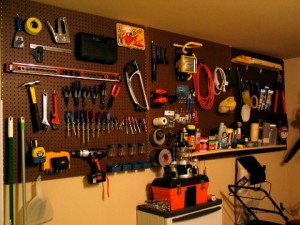Getting Organized
May 29, 2012 by
Filed under Blog
Garage Storage Options
The overhead space in your garage may be considered wasted space. If you don’t have a lot of usable or available floor space in your garage, then overhead storage racks are a viable option. It is a good way to store seasonal items, things that you don’t need on a regular basis, and anything that needs to be kept out of reach of children and pets. These are strong, secure shelves typically constructed of 14-gauge industrial-grade steel.
 Ceiling mounted shelving units, like the overhead storage units, are great space savers, and also keep things off the ground. These, however, hug the wall
Ceiling mounted shelving units, like the overhead storage units, are great space savers, and also keep things off the ground. These, however, hug the wall
and provide easy access. They typically include only the basic hanging structure, requiring you to purchase your own shelf boards.
Wall mounted units come in many styles, and you’ll find wall systems as well as wall shelving.
Pegboard, as mentioned in our last issue, is an affordable hanging option for tools and other items, but there are many other wall systems to consider that will hold a variety of things, such as the one shown here. You can find a variety of hardware and hooks to hold all sorts of items, and installation is simple.
 |
 |
 Slatwall systems have become much more affordable. You may have seen these in retail stores as fixtures, without giving them much notice. This is a versatile system for hanging things in your garage and, while similar to the system above, it consists of wall panels vs. strips. Just as the strip system, this one has a variety of hardware and hooks to hold your items, and you can also add shelving. Surprisingly enough, slatwall can even be found online at Target.
Slatwall systems have become much more affordable. You may have seen these in retail stores as fixtures, without giving them much notice. This is a versatile system for hanging things in your garage and, while similar to the system above, it consists of wall panels vs. strips. Just as the strip system, this one has a variety of hardware and hooks to hold your items, and you can also add shelving. Surprisingly enough, slatwall can even be found online at Target.
The most logical storage option is, of course, shelving units. You can choose from stand-alone units, wall-mounted or ceiling mounted units.
Stand-alone units are constructed out of plastic, wood, metal, or a combination of those materials, and most of us have one or more of these. They are typically easy to assemble and, with the exception of plastic, can be secured to the wall. They can be found in most any discount or home improvement store in all sizes. With this type of shelving, opt for quality and durability over price, as the most affordable is not always the one that will last. Heavy duty shelving is your best option for the garage.
If you are not handy and want built-in wood shelves, The Fix-It Professionals will be happy to assist you! For DIYers, you can find plans online to build them yourselves.
 Wire shelving units can be found in a variety of places as well. These units can either be stationary or
Wire shelving units can be found in a variety of places as well. These units can either be stationary or 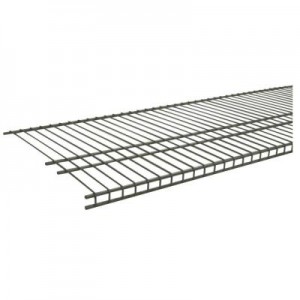 adjustable, are lightweight but strong, and are easy to assemble. They are popular and affordable, and can also be used in any room in the house (e.g. pantry or closet shelving). Some of these are stand- alone units as in the picture at the left, but some are also systems that are mounted on the wall. If you need mobility, you can buy wire shelving racks on wheels to move your things around the garage as needed.
adjustable, are lightweight but strong, and are easy to assemble. They are popular and affordable, and can also be used in any room in the house (e.g. pantry or closet shelving). Some of these are stand- alone units as in the picture at the left, but some are also systems that are mounted on the wall. If you need mobility, you can buy wire shelving racks on wheels to move your things around the garage as needed.
Getting your bikes up on hooks will free up more space for you as well. Take a look at these hook options, both vertical and horizontal, for your garage wall. Although designed for bikes, you probably can find other things that can be hung on them, to get them up off the ground.
 |
 |
 |
Your storage options and resources are virtually endless, especially if you do even a little bit of research on the internet. You can find any sort of shelving and hanging units to meet your own specific needs, so you can get that “stuff” put away. Good luck getting organized!
?>Garage or Mirage?
May 15, 2012 by
Filed under Blog
Seeing Your Garage in a New Light
 |
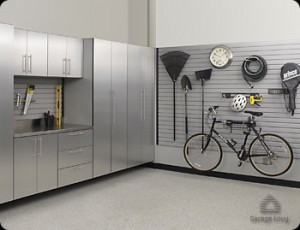 |
Ah, the garage…something we always want when we’ve never had one and then, when we get it, we eventually can’t use it!
Do you remember when you were able to put your car in your garage? Wasn’t it wonderful? Now, how much stuff do you have to climb over or push aside to find your lawn mower, a yard tool or maybe your washer and dryer? We need to find a way to turn the “garbage” back into a garage. Notice how similar those two words are!
you have to climb over or push aside to find your lawn mower, a yard tool or maybe your washer and dryer? We need to find a way to turn the “garbage” back into a garage. Notice how similar those two words are!
Wikipedia defines a garage this way: “A residential garage is part of a home, or an associated building, designed or used for storing a vehicle or vehicles.” Are you chuckling or rolling your eyes in exasperation?
So–let’s take a good look at a hot problem area. The reality is that, for most of us, our garages are multi-purpose areas, whatever the “proper” definition is! We keep workbenches, laundry and kitchen appliances, necessary storage and unnecessary clutter in the garage to keep it all out of the house…yet, the fine line between sensible and overwhelming often eludes us!
Here’s how to tackle this daunting challenge — plan, organize, plan some more, and then voila – a usable, functional space that meets the specific needs of your household.
First step – Define what you need. Do you have sports equipment that needs storage? Do you buy items in bulk that need to be put away until you want them? Is someone in your family a handyperson, making the workbench a necessity? Do you need room for pet paraphernalia? Does your garage also serve as a place for your washer and dryer? An extra freezer? Once you have defined your own personal needs, you can then focus on techniques for organizing.
The second step is to take photos or notes. Most of us have digital cameras or camera phones. Take pictures of the problem areas, along with notes for solutions. Print or download the pictures, add the notes, and you will see the beginning of a great organization system.
Next, focus on what to keep and what to toss. Do you have a broom with hardly any bristles? Sports or exercise equipment or very unique tools that you’ll never use again? An excess of holiday decorations that you don’t display any longer? Extra materials from your last house project? Let go of these things. Some can be tossed, and others can be donated or listed for sale on Craigslist or any local or regional for-sale site.
Now that you have the bones of what needs to be done, let’s “flesh out” the workability of your garage spaces. Here are the three key areas for which to plan–Walls, Ceilings and Floor Space. Each has its own importance in the organizing scheme.
 Ceilings can have added use with drop-down storage or permanent storage that provides a place to put seldom-used or awkwardly-sized or shaped items, such as skis, lumber, or seasonal decorations!
Ceilings can have added use with drop-down storage or permanent storage that provides a place to put seldom-used or awkwardly-sized or shaped items, such as skis, lumber, or seasonal decorations!
Floor space can, and should, be devoted to things you need access to regularly–garbage cans, washer and dryer (with overhead shelving) and your extra freezer or refrigerator.
Now make the plans become reality. Put up the shelving, the pegboard, the storage items that will make it possible to have neat organization for the items you have decided to keep. Plan to use plastic bins, which come in all sizes, to store perishables (including things like fabric or crafts) or dangerous chemicals out of reach. Label everything clearly, using a sharpie or label-maker. DATE your labels, as well as making a notation (on the container or in a notebook) each time you access the bins. Once a year, go through the bins, and if you haven’t accessed them for a year, it is time to discard!
Define each area, and store similar items together. Keep tools, pet supplies, sports equipment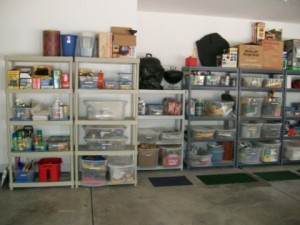 etc. in one accessible place. THEN KEEP THEM THERE! Get in the habit of returning items to the same place each and every time, for easy retrieval next time they are needed. Some folks use colored bins or labels to complete their method of organization – orange bins for Halloween, red for Christmas, green for gardening, etc. Pegboards can be similarly defined by using colored duct or cloth tape on the handles of tools, designating their use (plumbing tools, garden tools, car tools and so forth). Some people have gone so far as to outline the tool where it hangs on the pegboard, so there is no question about where to return it.
etc. in one accessible place. THEN KEEP THEM THERE! Get in the habit of returning items to the same place each and every time, for easy retrieval next time they are needed. Some folks use colored bins or labels to complete their method of organization – orange bins for Halloween, red for Christmas, green for gardening, etc. Pegboards can be similarly defined by using colored duct or cloth tape on the handles of tools, designating their use (plumbing tools, garden tools, car tools and so forth). Some people have gone so far as to outline the tool where it hangs on the pegboard, so there is no question about where to return it.
Now, take a moment to stand back and admire your work. How does your garage look now? If someone asked for a specific item, could you find it? Will a car fit in the garage now, should you want it to? Enjoy your feeling of accomplishment, and be sure you maintain the system you have so painstakingly put into place.
?>
Paving a Pleasant Path
Choosing a Walkway for Your Landscape

Since spring brings us to a place of starting or finishing projects, straightening up and cleaning out…how about that yard project you’ve pondered for a while now? You know, the one where you finally design that walkway of brick, stone, or gravel to enhance your landscape? Here are a few ideas of materials to help you get moving down your desired path:
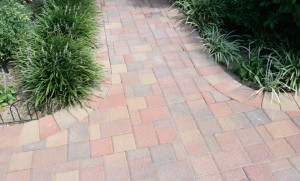 Pavers: Offering great versatility, pavers come in many sizes, shapes, colors and textures, and are much like indoor tile. Some of them are even designed to interlock to create a set pattern. You’ll find natural stone pavers as well as those machined into specific shapes. Pavers are usually set in compacted soil and gravel to minimize cracking.
Pavers: Offering great versatility, pavers come in many sizes, shapes, colors and textures, and are much like indoor tile. Some of them are even designed to interlock to create a set pattern. You’ll find natural stone pavers as well as those machined into specific shapes. Pavers are usually set in compacted soil and gravel to minimize cracking.
Bricks: Manufactured and used for hundreds of years, clay bricks are stillquite popular, and can be used in either formal or informal settings. Bricks work well in conjunction with other materials like natural stone and concrete. See the patterns pictured here to give you some ideas on design layout. Although uniform in shape, brick also lends itself well to curved path designs, and does not have to be laid in a straight line. It can be dry-laid or mortared. If dry-laid, it is recommended that bricks be set into a mixture of sand and dry concrete so they can move when the ground contracts. (Dry-laying permits water to filter down into the soil, allowing grass to grow between the bricks or stones.)
informal settings. Bricks work well in conjunction with other materials like natural stone and concrete. See the patterns pictured here to give you some ideas on design layout. Although uniform in shape, brick also lends itself well to curved path designs, and does not have to be laid in a straight line. It can be dry-laid or mortared. If dry-laid, it is recommended that bricks be set into a mixture of sand and dry concrete so they can move when the ground contracts. (Dry-laying permits water to filter down into the soil, allowing grass to grow between the bricks or stones.)
 Flagstone: As versatile as brick, flagstone also mixes quite well with other paving materials. Flagstone can be used for both formal and informal walkways, and provides options: you can cut this stone into a desired symmetrical shape, or use the natural, irregular shape for a more abstract design. This stone is primarily found in natural tones. Flagstone can be dry-laid or mortared over concrete.
Flagstone: As versatile as brick, flagstone also mixes quite well with other paving materials. Flagstone can be used for both formal and informal walkways, and provides options: you can cut this stone into a desired symmetrical shape, or use the natural, irregular shape for a more abstract design. This stone is primarily found in natural tones. Flagstone can be dry-laid or mortared over concrete.
Gravel: Simple, natural and affordable, gravel paths are quite popular. With many color choices and sizes available, for your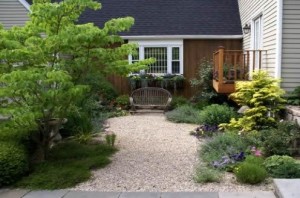 walkway, you’ll want a small sized rock that will compact well, such as pea gravel. Gravel walkways should be edged with a border that will keep these rocks in place.
walkway, you’ll want a small sized rock that will compact well, such as pea gravel. Gravel walkways should be edged with a border that will keep these rocks in place.
While you’ll need to consider your personal budget and cost of the materials you choose, don’t forget to consider maintenance, durability and availability of these materials in your area. Use your imagination and creativity to design the walkway that will bring you pleasure for years to come!
?>
